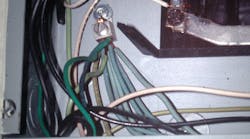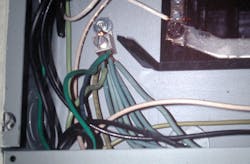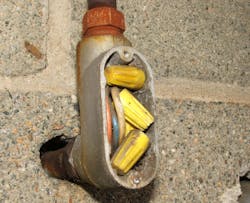What’s Wrong Here? Hint: If Two Is Company, and Three’s a Crowd — What’s 10?
How well do you know the Code? Think you can spot violations the original installer either ignored or couldn’t identify? Here’s your chance to moonlight as an electrical inspector and second-guess someone else’s work from the safety of your living room or office. Can you identify the Code violation(s) in this photo? Note: Submitted comments must include specific references from the 2011 NEC.
Hint: If two is company, and three’s a crowd — what’s 10?
‘Tell Them What They’ve Won...’
Using the 2011 NEC, correctly identify the Code violation(s) in this month’s photo — in 200 words or less — and you could win something to put in your toolbox. E-mail your response, including your name and mailing address, to [email protected], and Russ will select three winners (excluding manufacturers and prior winners) at random from the correct submissions. Note that submissions without an address will not be eligible to win. Winners will receive a fluorescent lighting tester from Milwaukee Tool, valued at $199. The product allows complete lamp, ballast, and pin testing, before or after install, without dismantling fixtures.
(*Please allow six to eight weeks for delivery of tools.)
October Winners
According to the general requirements in 314.16, boxes and conduit bodies must have sufficient size to provide free space for all enclosed conductors. More specifically, 314.16(C)(2) permits only conduit bodies that are “durably and legibly marked by the manufacturer with their volume to contain splices, taps, or devices.” The maximum number of conductors permitted is calculated in accordance with 314.16(B). As per 314.16(B)(1), “each conductor that originates outside the box and terminates or is spliced within the box is counted once.” This fitting contains two orange, two blue, two white, and two green 12 AWG wires for a total of eight 12 AWG wires. According to Table 314.16(B), 2.25 cubic inches are needed for each 12 AWG wire. Therefore, a minimum volume of 18 cubic inches would be needed, and this volume would need to be marked by the manufacturer on the conduit body in order for it to contain any splices. However, the conduit body in the photo is an “SLB.” According to 314.16(C)(3) [Short Radius Conduit Bodies], “Conduit bodies such as capped elbows and service-entrance elbows that enclose conductors 6 AWG or smaller, and are only intended to enable the installation of the raceway and the contained conductors, shall not contain splices, taps, or devices.”






